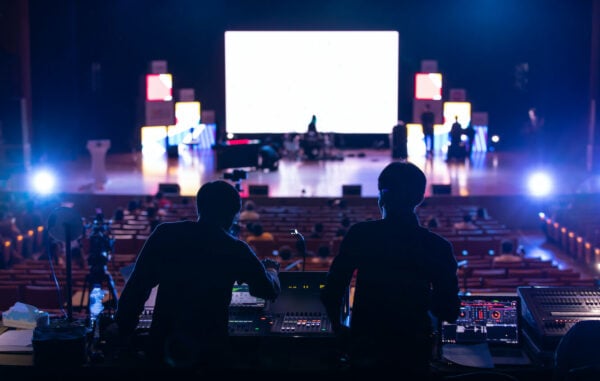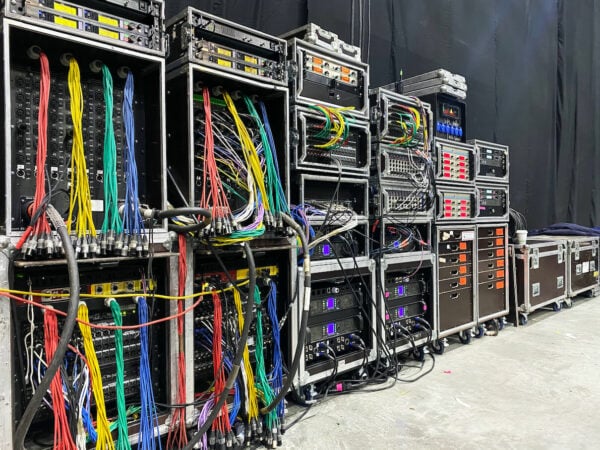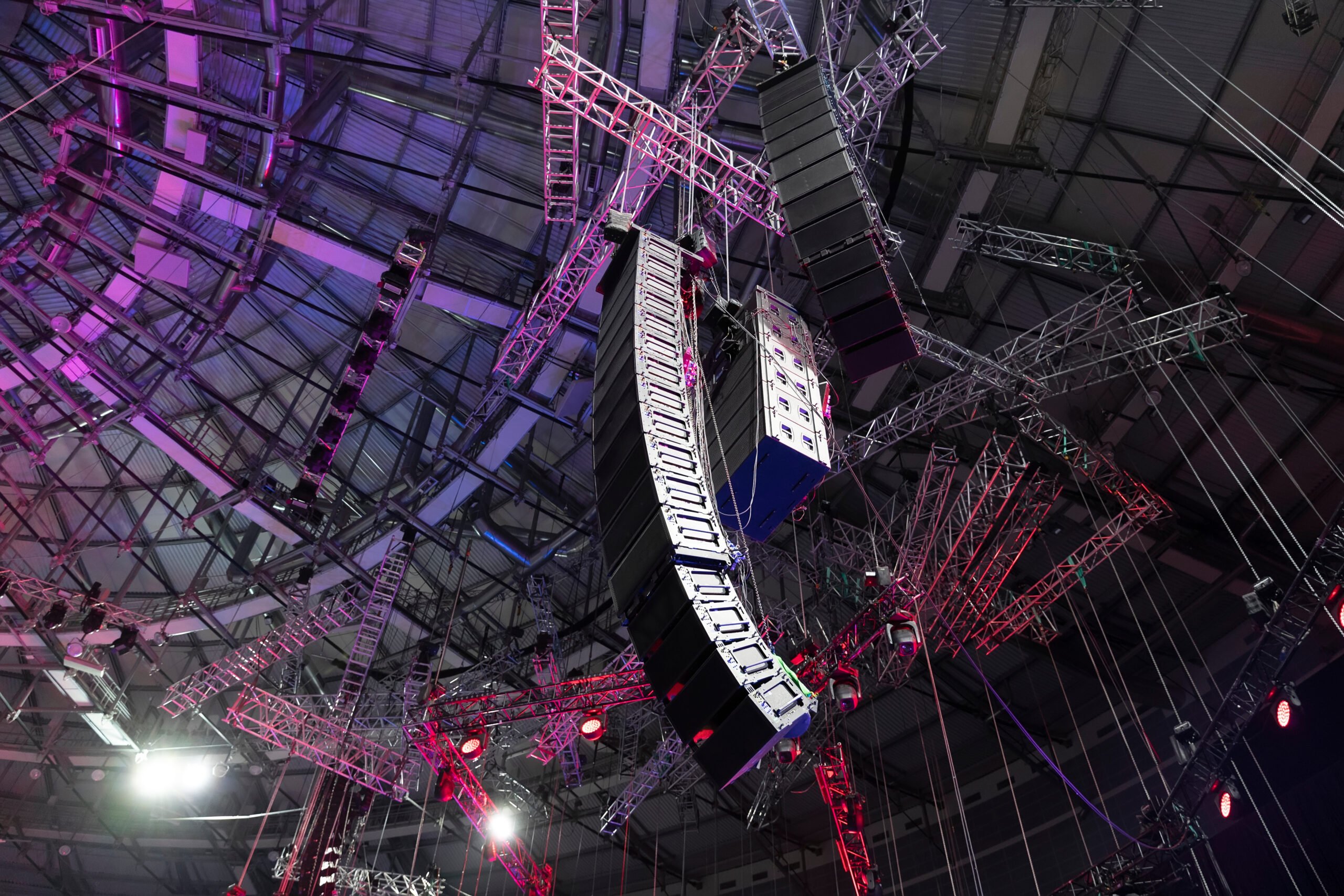What is Speaker Delay?
One of the most mind-boggling concepts in audio engineering and sound-system installation is audio latency. This phenomenon occurs when there’s a short difference—measured in milliseconds—between when an audio signal is passed into a system and when it is heard. The only way to fix it is by properly establishing speaker delay (which we’ll talk about later).
Many different factors can cause sound latency, including audio processing and conversion, transmission time, and buffering. The most evident cause of audio latency in live-sound reinforcement settings, though, is the limitations of the speed of sound in the performance space.
In school, you probably learned that the speed of light is much, much faster than the speed of sound. In fact, light is nearly nine-thousand times faster than sound, with light travelling at approximately 3,000,000 meters per second and sound only traveling about 340 meters per second. That’s the whole reason you see a lightning strike before you hear it, and that’s also why you can figure out how far away a lightning strike is by counting the seconds between the strike and its rumble. Get the idea?
The issue with the speed of sound in event spaces comes when you have sets of speakers (speaker lines) installed at various distances from the stage in order to provide sound to the entire audience. For example, if the above-stage speakers and front-fill speakers are 20 meters away from each other and play a sound at the exact same time, the audience will hear the sound twice: first from the front-fill speakers, then from the stage speakers about 58 milliseconds later—almost like an echo. This latency can reduce your audience’s ability to understand the sound you’re playing back and can be generally annoying.
How do you fix this problem? Well, you simply tell your front-fill speakers to wait 58 milliseconds before playing the sound! Then your audience will hear from both speakers at the exact same time. It’s that easy.
As you can tell, audio latency can result in lots of problems in live performance and cause a poor audience experience. So, audio engineers and sound-system installers have to account for this latency in their respective venues by properly delaying their speakers to align with each other.
But how can you add delay to your speaker system so all the sound lines up? The way to do this is to first calculate the speaker delay for your performance space.
How is Speaker Delay Calculated?
It’s not very difficult to calculate sound delay. In fact, you read how it works in the above section! The speaker delay or “time alignment” formula is as follows:
Delay needed on speaker line in question = Distance between main speaker line and speaker line in question divided by speed of sound
E.g. 0.058 seconds (58 milliseconds) = 20 meters divided by 340 m/s
There you have it! You have everything you need to know to measure time alignment and speaker delay. Now, you just have to delay the speaker line in question by the number of milliseconds you calculated above, and you’ve entirely reduced that annoying echo for your audience.
Now, if you apply this process to each speaker line in your venue, you’ll have a perfect system of delay rings that allow for a great, clear live sound.
Setting the Delay on Your Speaker System
But how do you actually apply delay to your speaker lines and tell them when to sound? Well, that’s what a rack-mounted speaker-delay unit is for. Essentially, this unit will split your signal into different channels which you can feed to your speaker lines. You can then tell the unit how much delay to add to each channel.
Of course, for digital-signal processing, you can use delay and speaker time-alignment software to achieve the exact sound you want as well.
Then, you just have to go into the house and perform a speaker delay test! This is to make sure that every part of the venue hears sound clearly and without echo.
The Haas Effect in Live Sound
The Haas effect, also known as the precedence effect, is a psychoacoustic phenomenon (i.e., something that happens while our brain is processing sound) where, if we hear two sounds played within a short time of each other, we perceive them as only one sound. If we hear those sounds played farther apart than that short time difference, we perceive them as an echo. This effect was described by Dr. Helmut Haas in his 1951 P.h.D. thesis.
The short time period where our brains think two sounds are the same sound can vary depending on the type of sound being played. For example, our brains perceive clicking sounds within 1 to 5 milliseconds of each other as the same sound. For speech and music, our brains can handle up to about a 40-millisecond difference between sounds before perceiving an “echo” effect.
Additionally, he explains that if a person hears a sound from two sources that are slightly (but not completely) delayed from each other, the person will perceive the sound as originating from the source that first sounded—not from the second.
Audio engineers can use this knowledge to make their audiences perceive that all a concert or event’s sound is coming from the stage, when really a majority of it is coming from lines of speakers throughout the house! They just have to delay the sound coming from a speaker line by about 20 milliseconds after the main stage sound passes that line.
In essence, to get an expert-level live sound, you have to properly set your delay rings to both cancel out the speed-of-sound latency and add a little delay to create a natural sound that appears to come from the stage (via the Haas effect).
How to Time-Align Speakers
Time alignment, at one point, only applied to large auditoriums. Now, though, due to marketing trends by speaker manufacturers, many people discuss time alignment on a very small scale—within an individual speaker. Although the auditory difference between a “time-aligned” speaker and one that isn’t “time-aligned” is essentially imperceivable, many people are passionate about this subject, so we’ll cover it here.
If you know how the speed of sound can create latency, loudspeaker time alignment isn’t difficult to grasp.
Our example will use a two-way speaker, one that internally contains two drivers: a high-frequency tweeter and a mid-to-low frequency woofer. Because of the different sizes of these drivers’ cones, they are placed at different depths within the speaker. The couple of inches between the voice coils of the two drivers causes a nearly negligible delay to occur—we’re talking about a fraction of a millisecond delay between the tweeter and the woofer.
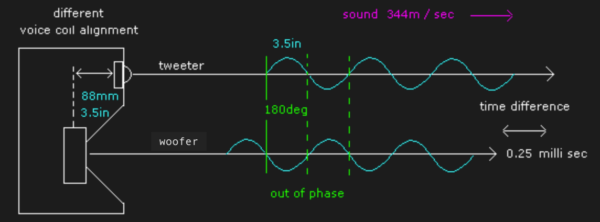
Source: Leonard Audio Institute (http://education.lenardaudio.com/)
So, some speaker manufacturers have decided to design speakers where the voice coils of both drivers are perfectly vertically aligned to eliminate this imperceptible delay. They do this by simply placing the woofer farther out from the speaker box than before so that its voice coil aligns with the voice coil of the tweeter.
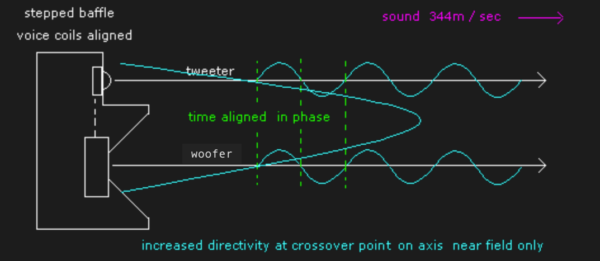
Source: Leonard Audio Institute (http://education.lenardaudio.com/)
This same idea can be applied to main and subwoofer systems. To achieve perfect subwoofer time alignment, you can vertically align your subwoofer’s voice coil with your main’s voice coil and eliminate the tiny subwoofer delay that would exist otherwise.
That’s it! We hope that this Gearsupply Guide was able to help you wrap your mind around latency and delay in live-sound reinforcement. If you have a second, you should stick around and browse the current selection of equipment on Gearsupply—an online marketplace where events-industry professionals can buy and sell audio, video, lighting, and stage equipment for ultra-low prices. You can register as a free member here.

